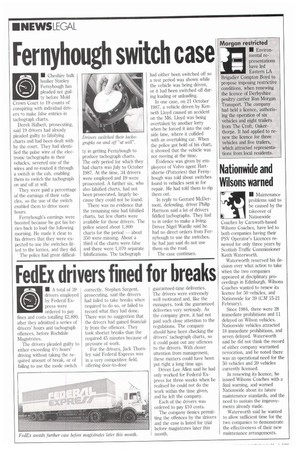Fernyhough switch case
Page 24

If you've noticed an error in this article please click here to report it so we can fix it.
• Cheshire bulk haulier Stanley Fernyhough has pleaded not guilty before Mold Crown Court to 19 counts of conspiring with individual drivers to make false entries in tachograph charts.
Derek Halbert, prosecuting, said 19 drivers had already pleaded guilty to falsifying charts and had been dealt with by the court. They had identified the pulse wire of the electronic tachographs in their vehicles, severed one of the wires and re-routed it through a switch in the cab, enabling them to switch the tachograph on and off at will.
They were paid a percentage of the earnings of their vehicles, so the use of the switch enabled them to drive more hours.
Fernyhough's earnings were boosted because he got his lorries back to load the following morning. He made it clear to his drivers that they were expected to use the switches fitted to the lorries, and they did.
The police had great difficul ty in getting Fernyhough to produce tachograph charts. The only period for which they had charts was July to October 1987. At the time, 34 drivers were employed and 19 were prosecuted. A further six, who also falsified charts, had not been prosecuted, largely because they could not be found.
There was no evidence that the remaining nine had falsified charts, but few charts were available for those drivers. The police seized about 1,800 charts for the period — about 350 were missing. About a third of the charts were false and there were 1,070 separate falsifications. The tachograph had either been switched off so a rest period was shown while the vehicle was being driven, or it had been switched off during loading or unloading.
In one case, on 21 October 1987, a vehicle driven by Kenneth Lloyd caused an accident on the M6. Lloyd was being overtaken by another lorry when he forced it into the outside lane, where it collided with an overtaking car. When the police got hold of his chart, it showed that the vehicle was not moving at the time.
Evidence was given by employees of Volvo agent Hartshorne (Potteries) that Fernyhough was told about switches found in vehicles sent in for repair. He had told them to rip them out.
In reply to Gerrard McDermott, defending, driver Philip Harrison said a lot of drivers fiddled tachographs. They had to in order to make a living. Driver Nigel Wardle said he had no direct orders from Fernyhough to use the switches, he had just said do not use them on the road.
The case continues.














































































































